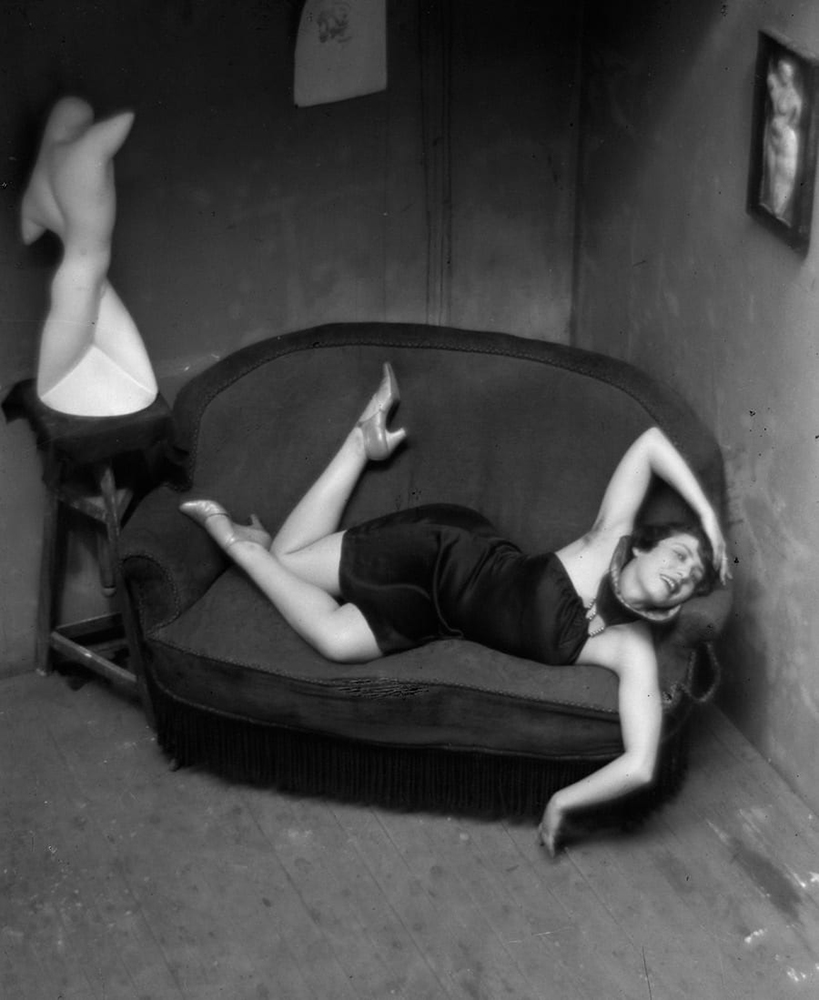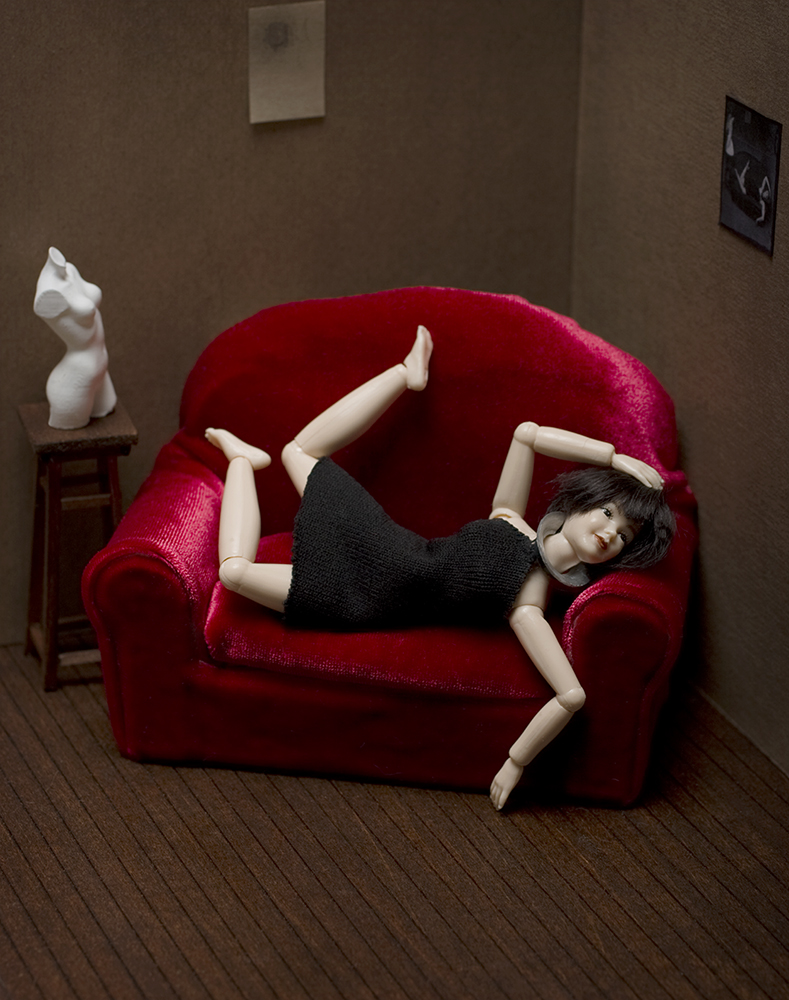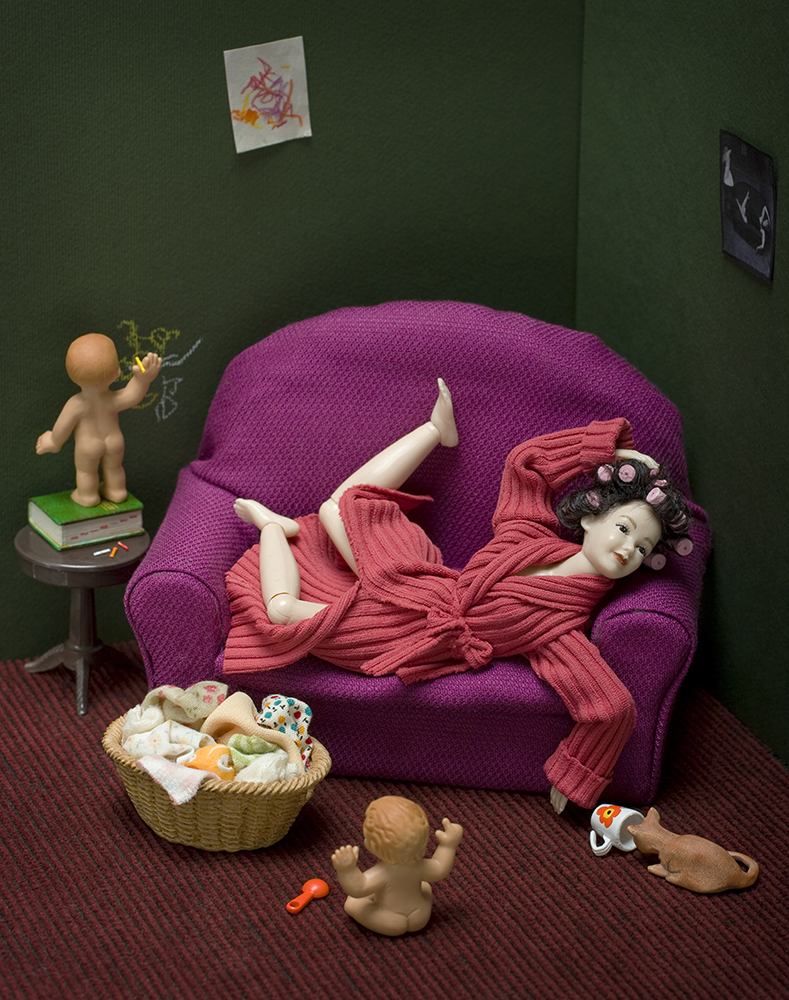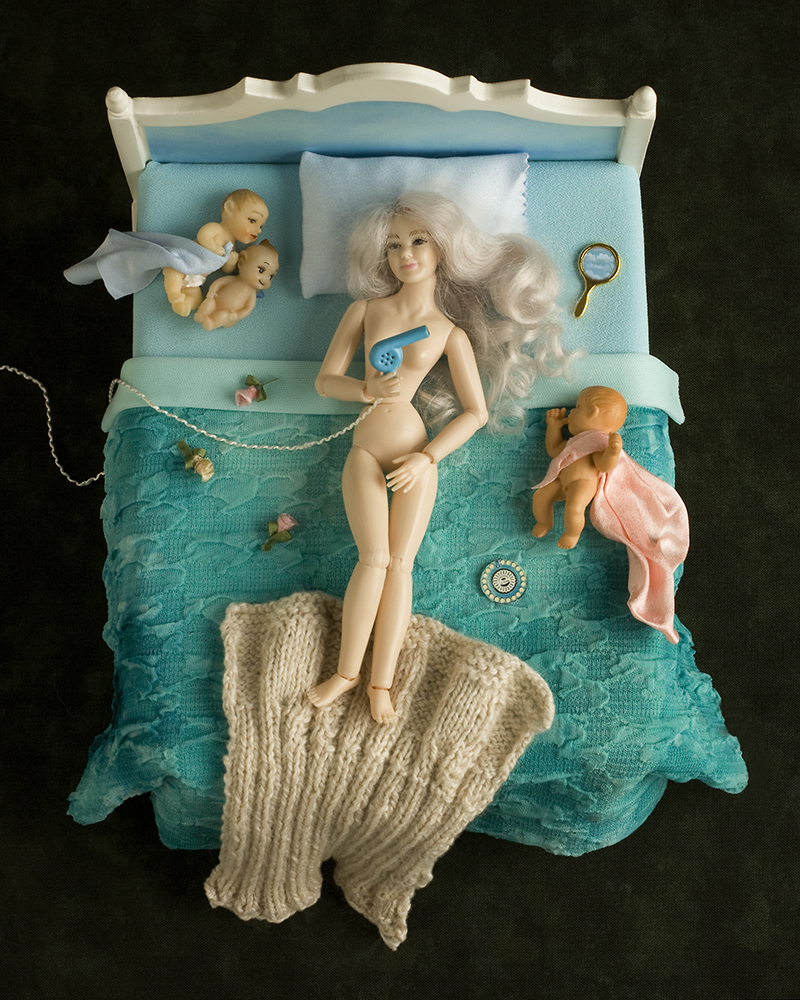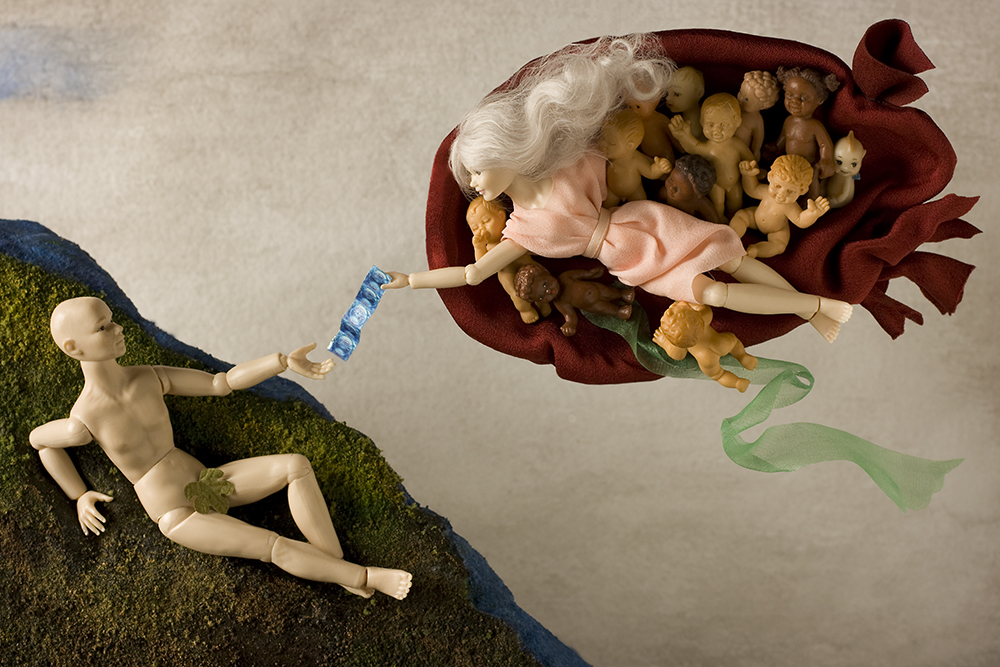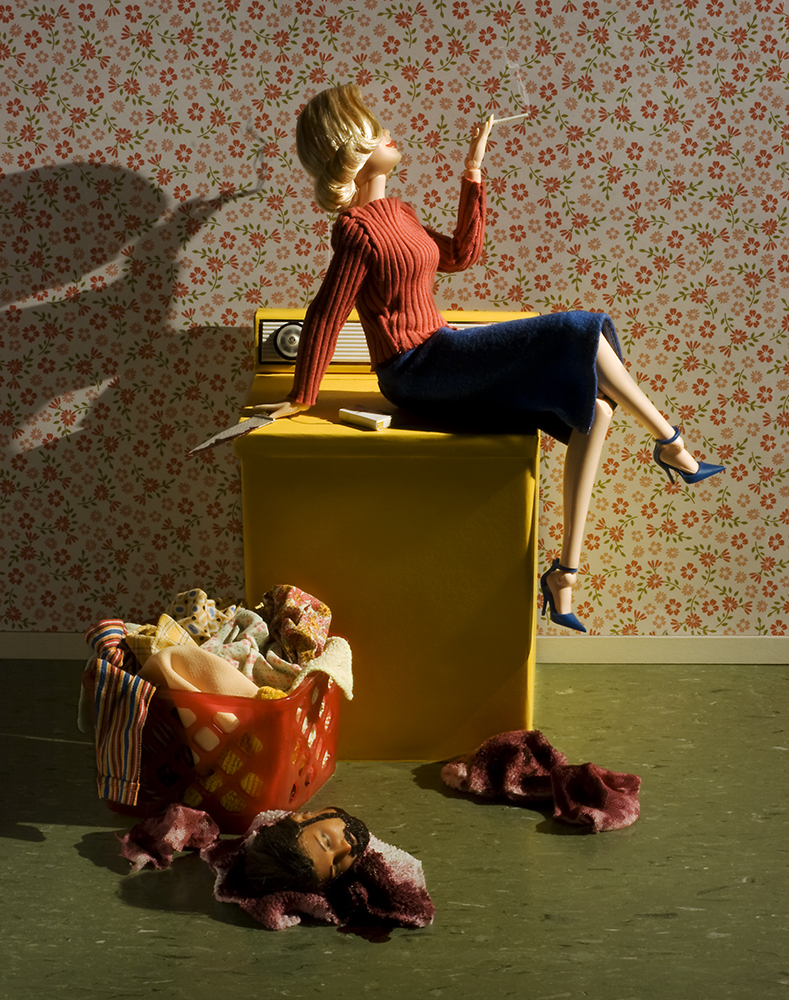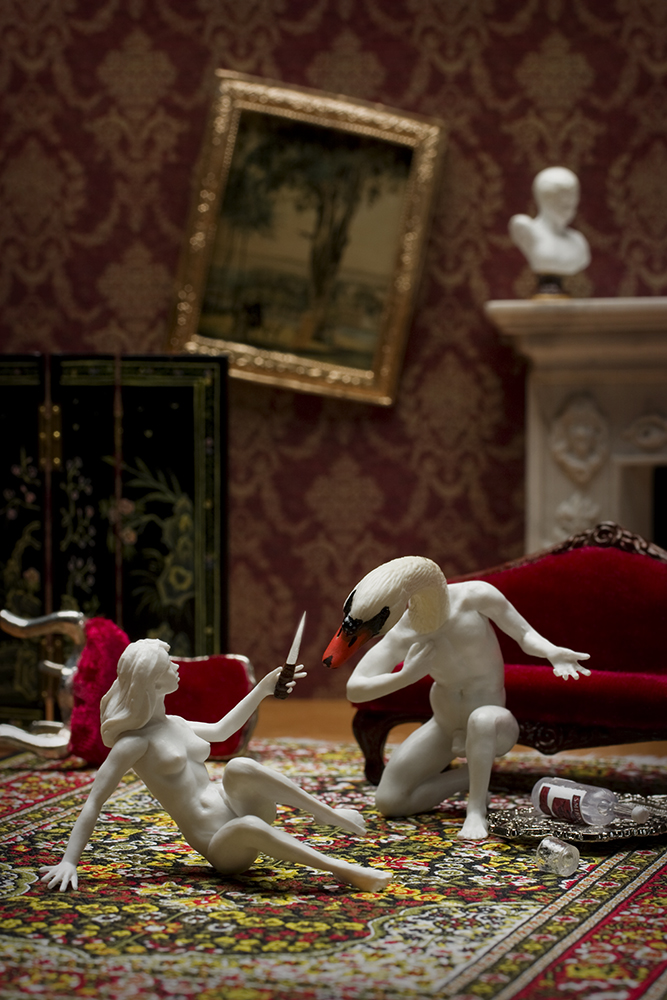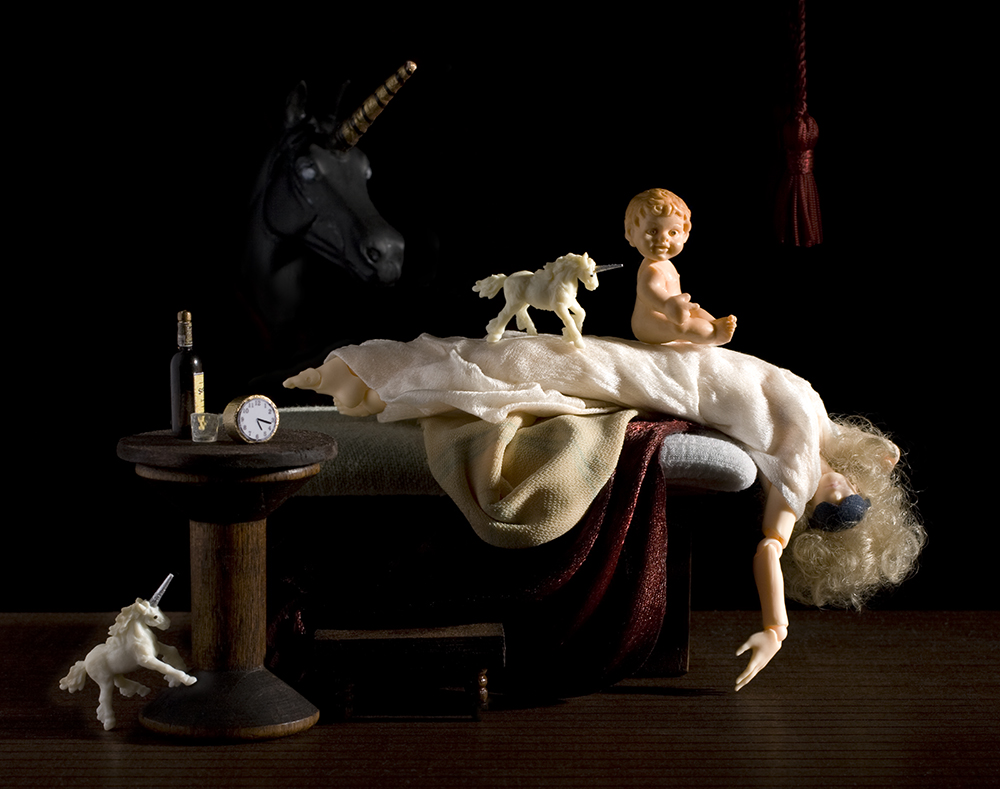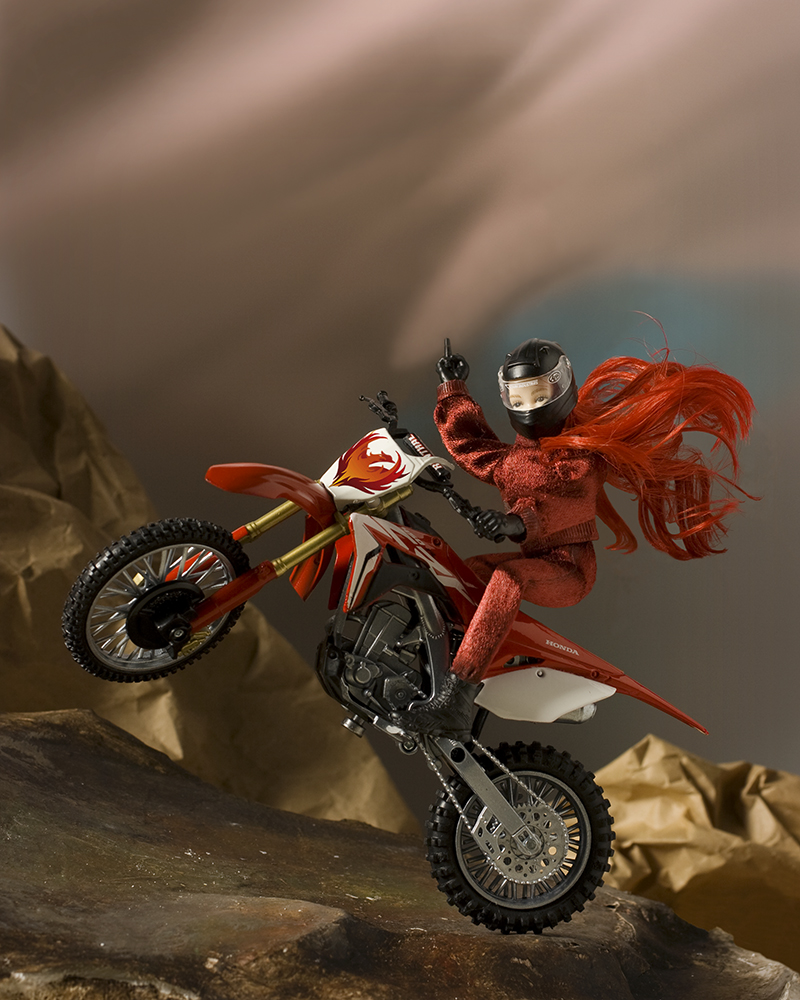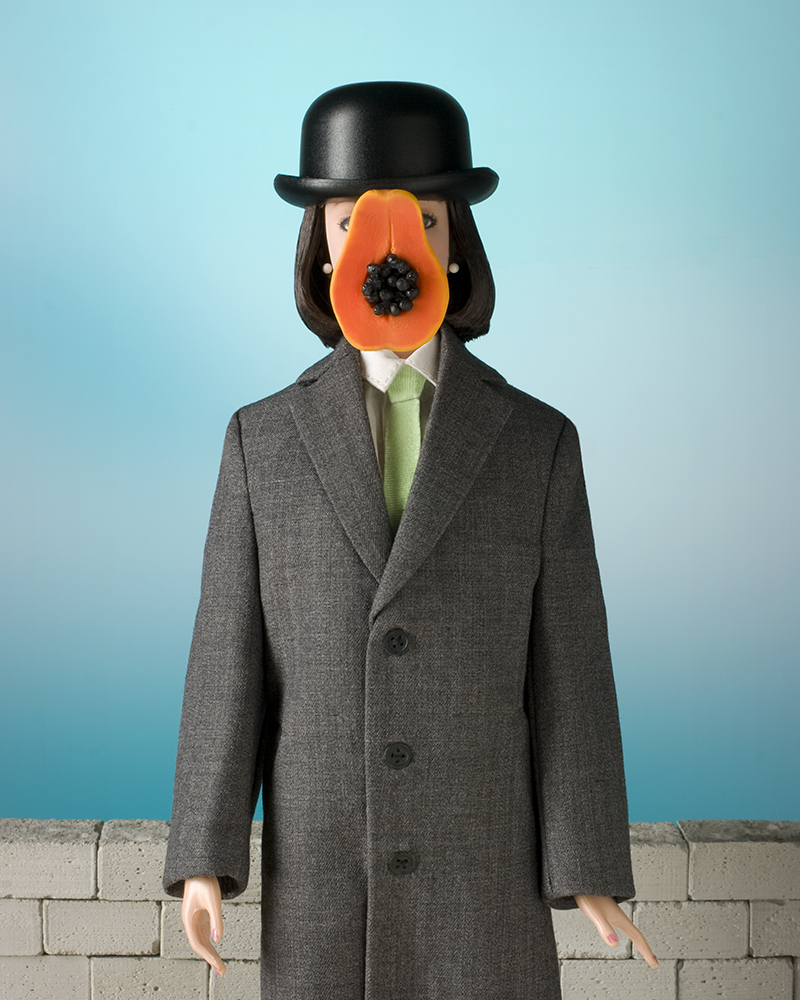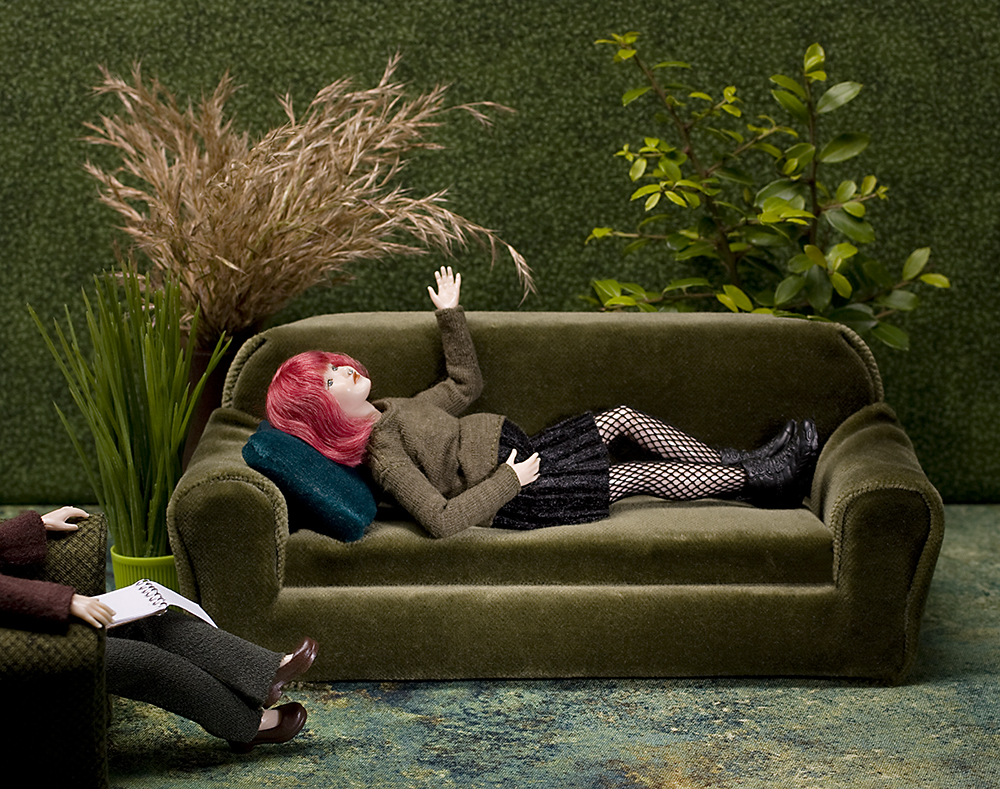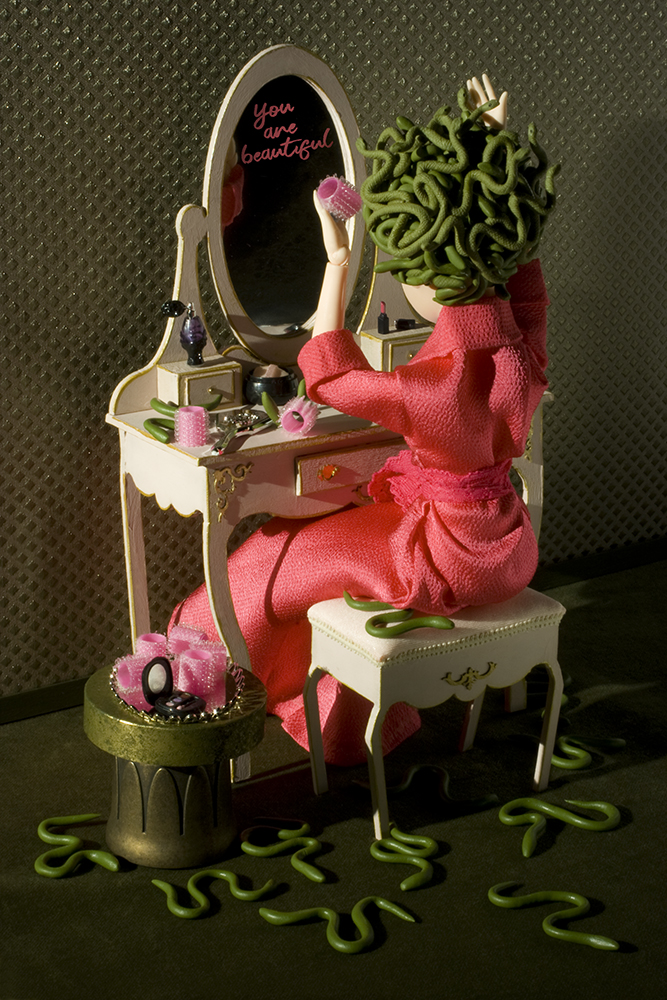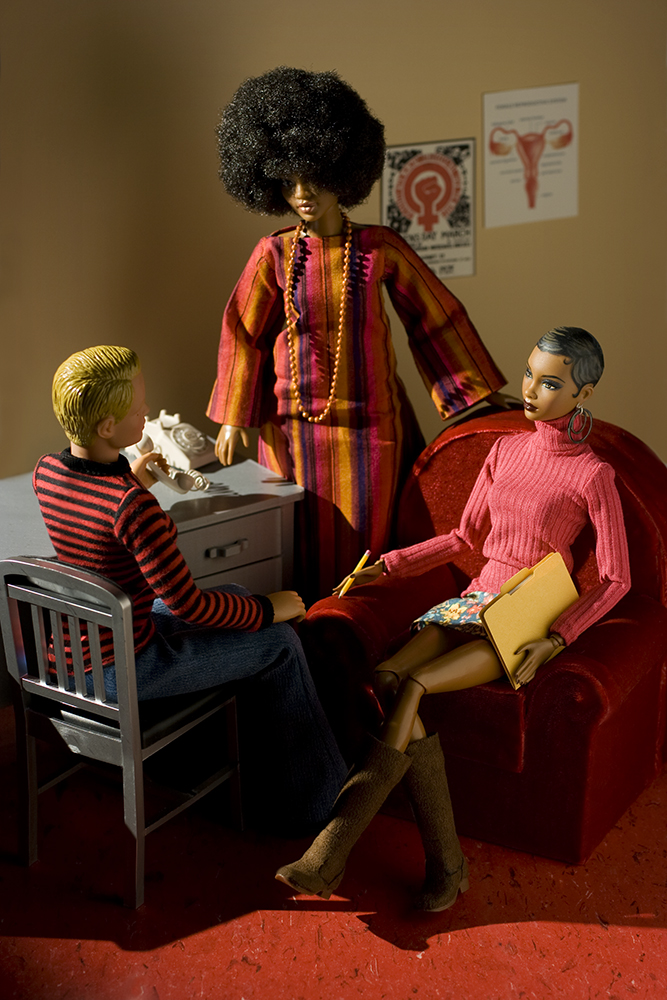Grace Weston: Reclaiming the Muse
There is an opening scene in the movie, Barbie, that is a shot by shot replication of Stanley Kubrick’s masterful look at apes discovering tools, in the movie, 2001. The Barbie movie replaces the apes for a group of 5-year-old girls playing with baby dolls who angrily discard not only the dolls, but the role of caretaker and mother when they are offered a different future for themselves, once exposed to the massive presence of a woman in full bloom: Barbie. Not unlike the brilliant directing of Greta Gerwig, Grace Weston has a legacy of seeing the world from a unique female perspective.
Her new series, Reclaiming the Muse, re-examines the history of art and myth through the female gaze. Her miniature tableaux are at the same time magical, humorous, and thought provoking, as she deftly uses dolls to recreate classic patriarchal tropes of womanhood.
There is lots coming up for Weston, she is opening a solo exhibition at the Landau Gallery (@landaugallery), has work in Critical Mass Top 50 exhibition exhibition at the Colorado Photographic Arts Center through April 13th, 2024, in May of 2024, she opens an online solo show, Photographic Performance, at the Smith Gallery, and will open a solo show in June 2024 at the Southeast Center for Photography.
Reclaiming the Muse
I work in the genre of staged photography, creating miniature scenes with characters, props and sets that I source, alter, or fabricate from scratch, to then light and photograph. Although I never depict actual people in my photographs, the human psyche is undeniably at the center of my work.
The first photo I ever fell in love with was “Satiric Dancer”, the 1926 black and white image by Andres Kertesz. Decades later I decided to recreate it in miniature and in color. While working on the set, I became curious about the muse, the “dancer”. Who was she? What was her life like? Why did we know so much about the photographer, but nothing of his subject? After some research, I uncovered her name (Magda Förstner) and that she had been a cabaret performer with a successful career of her own. But other than that, she is lost to history.
Next, I restaged the scene once again, but into a contemporary setting. I removed the muse from the romanticized vision of the decorative object and portrayed her negotiating the unglamorous, overwhelming reality of daily life as a mother of two toddlers. This image is titled “Mother’s Day”.
This led me to consider other muses represented in old stories, historic paintings, and mythology, often depicted as objects of beauty or scorn. What if I restaged them in contemporary scenes with more agency and complexity in their lives? My series “Reclaiming the Muse” was born. Mythos, power dynamics, gender roles, liberation, empowerment, and self-preservation are explored in this series, all with a deceptively playful overlay, while rallying against the male gaze.
Of course, creating variations and reinterpretations of past tales and depictions is not a novel idea, but rather an age-old tradition, practiced throughout art history. I am fascinated by the psychological landscape, our search for meaning and the contradictions of human existence. So many stories, myths and artworks throughout history address these same concerns. I have found an abundance of rich source material to inspire my own interpretations for this ongoing series.
Grace Weston creates narrative photography in her studio with miniature staged vignettes that address psychological themes. Among her many honors, most recently Weston made the Top 50 in Photolucida’s Critical Mass 2023, and from that was awarded the additional prize of a solo show for 2024 at the Southeast Center for Photography in Greenville, South Carolina. Weston was honored by curator Ann Jastrab with the solo exhibition in All About Photo’s Showroom for the month of November 2023, resulting in further interviews and features in professional photography magazines and blogs worldwide in several languages. She won both First Place Overall Portfolio category as well as Gold Winner in the Fine Art Portfolio category in the 2021 Tokyo International Foto Awards. She has earned fellowships from both the Oregon Arts Commission and Artist Trust (Washington State), nominations for Portland Art Museum’s Contemporary Northwest Art Awards (Oregon), and numerous grants during her career spanning more than 25 years. In 2012, she had her first European solo exhibition at Paci Contemporary in Brescia, Italy. An extensive exhibition of her work was shown at the Center for Photography in Yekaterinburg, Russia in 2021. She has exhibited widely in the US, as well as Europe, Scandinavia, Russia, and Japan. In 2009, she was a finalist in PhotoEspana’s Descubrimientos exhibition in Madrid. Weston was named one of the “Nine to Watch” in the Whatcom Museum Photography Biennial (Washington) in 2008.
Weston’s work has been acquired by the Portland Art Museum (OR), the Amon Carter Museum of American Art (Fort Worth, TX), the University of the Arts (Philadelphia PA), Seattle Public Utilities Portable Artworks Collection (WA), King County Public Art Collection (WA), Photographic Center Northwest (WA), Portland Community College (OR), King County 4Culture (WA), the City of Seattle Portable Works (WA), as well as numerous private collections in the US, Europe and Japan.
Weston’s signature photography has been commissioned for print magazines and book covers in the United States, Italy, Spain, China, and the Netherlands, including O, the Oprah Magazine, Discover magazine, and Geo Magazine (Italia). She is included in the book Microworlds (Laurence King Publishing, UK 2011). In 2020 Peanut Press published a monograph of her work entitled The Neighbors Will Talk. In 2023 she self-published Character Studies, Up Close and Personal, a book of extreme close-up portraits of miniature characters from her collection.
Follow Weston in Instagram: @gracewestonphotography
Tell us about your growing up and what brought you to photography.
I grew up in a working-class family in central New Jersey. My dad was an avid reader and a lover of the arts. He shared that passion through books with me from an early age. I knew about Impressionism and Surrealism by the time I was in first grade. As soon as I was old enough, he would bring me to the museums in New York.
I went to a community college in New Jersey that had great architecture and art programs. The campus was brand new, and our art teachers were working artists, many of whom showed in Manhattan galleries. I really struggled with painting and printmaking, but I had a knack for photography. I got a lot of encouragement for “my eye” from my teacher. I became the darkroom assistant with the benefit of all the access to the lab I wanted. I continued with black and white film work out in the field for years.
What initially drew you to the world of miniatures?
In 1990 I assisted a studio photographer and realized that in the studio I could start with a blank canvas to create imagery from my imagination instead of “treasure-hunting” for images out in the world. Once I got over the initial learning hump with the equipment (lighting, large format cameras), I worked on still life images. I really loved lighting and every shot presented new problems and lessons. But my early images were rather “romantic”, like other work I’d seen, and not really my voice. I was trying to find my way. My first “successful” image that felt true to me was not a miniature, but life-size, much like a stage set, with a beautiful, swagged orange velour curtain, a painted backdrop of a sky with puffy clouds, an art deco rug, an open-doored bird cage, and a suitcase with a taxidermy bird perched on the handle, ready to fly away with it. I brought in the lighting, which seemed to cast a magical depth and beauty to the story, and I instantly could see that I wanted to do narrative work. (Sidebar – that has been one of my top-selling images, even licensed to illustrate an article in Oprah’s magazine.)
The next Image I made was with a small room set with a toy baby toddler crawling across a checkered floor towards the camera to get to a bright baby bottle bigger than him. I had so much fun tiling the floor, potato printing a pattern of baby bottles on the wallpaper, and setting up this silly scene, it just had me laughing. I think there is an Inherent nature to act out narratives with miniature characters – it’s what we naturally do as children.
With miniatures, I don’t have to build big sets, pay models, hire carpenters, or model makers, rent props, or find storage space for big stuff. I can have complete control. I can take all the time I need, on my own schedule. It doesn’t cost me a fortune to experiment, make mistakes or have ideas not work out. And I get to break out and dance in the privacy of my studio any time I feel like it!
Can you describe your workspace and a typical day?
I am incredibly grateful for my dream-come-true studio several steps from my back door, designed by my architect spouse. We planned it for many years, and it got postponed repeatedly until we finally built it in 2016. It makes all the difference to have my studio conveniently close, and available all hours of the day. It’s got great mojo – I feel so good the minute I step in there.
Is there a typical day? I’d say it’s more what’s a typical month! 3 days a week I get to a pool to swim laps. It’s awesome for dealing with stress in the most joyful way.
There’s always office work, too much of it, which I try to chip away at in the mornings. Studio time could be doing research for images I’m planning, sourcing props, sketching ideas, mulling through YouTube tutorials, making tiny clothes, or reupholstering doll furniture… the fabrication process takes the most time, and I’m constantly diving into materials and methods that are new to me. That part can take weeks, even a month or more (including failed attempts), but I enjoy it immensely. At the same time, I’m roughing in the actual set, deciding on scale, backgrounds, camera angles, character support systems, and placement. Then on a later day, when the props and characters are ready to go, I finalize the positioning and bring in the lights. The lighting is what really completes the illusion, and as I tweak and refine, it starts to feel like magic in front of my eyes.
Then there are the following days on the computer, cleaning up the image in Photoshop to prepare for printing. I use the program very sparingly – mainly erasing support systems, like wires – primarily because I’m not very versed in the program and, though necessary in processing digital files, it’s my least favorite part of my process. I know there are Photoshop tools and abilities that could help me with many of the problems I encounter, but I’ve been lazy to learn those new skills, and I really enjoy the sleight of hand of creating illusion in-camera with optics and lighting.
You must have an amazing collection of miniatures! Did you have a doll house when you were growing up?
Not a doll house per se, but I remember cutting a shoebox down to make a curved top trailer to be hauled by my toy VW Bug, and then making pipe cleaner people with crepe paper clothes to ride in it.
I have always been enchanted by miniature items. I have a treasured quarter-inch realistic acorn hand-made out of woven white thread I’ve held onto for decades. I don’t even remember where I got it, but I always know where it is.
Now I have multiple drawers filled with miniature items and characters, roughly organized in some system understood only by me. Sometimes when I feel blocked between images, I just take some out to play with for inspiration.
You have become a master at creating tiny tableaux filled with small hand crafted details. Can you share some of your favorite and most difficult constructions?
Venus & The Pill is one of my most recent favorites. The doll had the perfect face and hair that inspired me to think of Botticelli’s Venus. I research these stories, which helps to inform my work on my series, Reclaiming the Muse. Mythology is filled with very bizarre details and jam-packed with misogyny! Plenty of rich material to inspire. The back story of Venus’ birth is that the God Uranus had a son named Cronus who overthrew his father, castrating him and throwing his genitals into the sea, causing the water to foam with Uranus’ fertile fluids, and from that sticky mess, Venus was born.
I love the color palette of that piece. I already had the white bed. I papered the bed’s headboard to mimic a sky. By pure serendipity I found that fabulous fabric for the blanket to suggest the ocean waves in the painting. To solve the impression of her half-shell, I knitted the little beige throw (after watching YouTube videos to learn how.)
One of the biggest difficulties in staging miniatures is getting fabrics to have the illusion of weight, and to stay in place. I often use a starchy spray to “mold” the folds, but not all fabrics respond to that treatment. I found fabrics that complied for Venus’ babies’ blankets. With Botticelli’s Venus being depicted as so virginal, and with current day misogyny threatening women’s rights to their own bodily choices, I knew I wanted the birth control pills in the image. The hair dryer was the final touch, relating to the wind blown by Zephers in Botticelli’s painting. My Venus has taken on the demands of balancing three babies while keeping up her appearance. A little fun fact – in mythology, Venus gave birth to Cupid, and if you look closely at my piece, you will see the smallest baby has little wings. This piece was so satisfying and great fun to do.
Currently I am working on a piece that has an old woman in it, and she needs to be naked. Well, as you might imagine, I cannot find a 1:12 scale realistic nude old woman doll! I have a one that is a “grandma”, but her torso is stuffed fabric and is intended to be covered with clothes. So, I have removed the fabric down to the underlying wire armature, and now I’m on YouTube studying figure sculpting. This is not in my current skillset, and I hope I can do it justice at the small scale, knowing that the final close-up photograph will show every detail. It is challenging to even find reference photos of naked old women (no shortage of young women, of course!) In case it hasn’t been clear, after a certain age, apparently women are supposed to disappear, or at least remain fully clothed, which perfectly underlines the point I intend to make with this piece.
The dolls you use seem unlike doll house dolls or even barbie dolls…they are so well articulated. Small hand gestures often make the image. Are these a particular type of dolls?
My favorite scale is 1:12 (1-inch equals 12 inches), so the doll is only 5” tall. The most charming ones are Heidi Ott dolls that I used to buy from a woman in Australia, but recently she has had trouble getting them from the manufacturer, and they are very hard to find anywhere else. I also find good vintage dolls on rare occasion, but there’s a certain level of realism that I require, and the more articulated, the better.
I work with other scales, too (1:6 is Barbie scale), so fabricating realistic clothes or sourcing them is easier – but the backgrounds, sets and props need to be larger, and that can present other challenges. I also don’t like to show actual Barbie faces very often, just because she has such strong associations for people, and I prefer more “anonymous” characters that I can project an identity onto.
What drew you replicate famous photographs and paintings?
Well, the first one that came about was a literal restaging in miniature and in color of Andres Kertesz’ Satiric Dancer. It was my first favorite photograph as a teen. I thought it was such a wild scene with such a fun-loving muse. I longed for that time – Paris in the 1920’s!
While restaging the scene I started to wonder about the muse herself, what her life was like, what became of her. I researched to discover she had been a cabaret performer, successful in her own right, but, while Kertesz’ photograph is famous, she was lost to history. Then I staged her in contemporary terms, as a mother, her wild days behind her, juggling two toddlers and endless housework, resulting in my image Mother’s Day. That eventually led me to consider other muses in historic artworks and stories, presenting them from a more fleshed out, woman’s point of view, rather than as passive objects of male projections of beauty or scorn. This has given me an inspiring and unifying direction, with plenty of source material to explore. I love researching the back stories of each piece that I tackle for this series, Reclaiming the Muse.
Can you talk about your wonderful installation with your project Escaping Gravity?
In 2018 I presented a photo-based multi-media multi-dimensional installation at Nine Gallery in Portland entitled Escaping Gravity: Breathing, Dying, Swimming, Flying about my eight-year-old brother’s death by drowning when I was four, my eventual learning to swim late in life, and the liberation that brought me.
This installation was a departure from my usual framed narrative miniature vignettes, but I still wanted to include photography of miniatures. I photographed a green-hued miniature staged scene of an underwater view of a turtle and a boy’s floating body. Then I staged a different set-up of miniature “swimmers” to photograph through water, swirling the water with utensils to create distortion and to catch the sparkles of light. After hundreds of images, I chose five distorted swimmers to print on 5-foot chiffon banners.
Within the gallery room, I created two chambers, a “Pond” and a “Pool”. The viewer entered the green Pond chamber, which held a large chiffon banner printed with the underwater scene of the turtle and the boy, as well as newspaper clippings and pages from a grief-laden letter my mom had drafted the week following my brother’s death. Beyond a curtain of streamers dividing the two chambers was the larger chamber, the blue Pool. There, the large chiffon swimmer banners hung from the ceiling. Rotating theater lights projected an illusion of blue rippling water on the ceiling, while fans gently blew the chiffon banners and a looped recording of bubbles and splashes played in the background.
Swimming is very meditative. It’s quiet, rhythmic, and a perfect atmosphere for the mind to muse. It makes sense that I often think of my brother. What was his experience of drowning that day? What would it have been like to grow up together? What would he be like as an adult? I miss what could have been.
This was the most challenging, personal, and vulnerable work I’ve ever done. From concept to installation took a full year and was followed by nearly two years of creative block. Ultimately it was incredibly rewarding, and I have no regrets. I’m very proud of that work. But it was brutal.
What is inspiring you lately?
Our community of photographers! I look at photography constantly, especially what’s happening now. I feel the field has blown open – anything goes, and there is so much outstanding creativity pouring forth. I really enjoy Instagram and the community of photographers, especially women, with whom I connect. It’s so inspiring to see people share their work, their exhibitions, and successes, and I discover new artists every day. Art has been the lifesaver, the antidote for so much depressing news we’ve all been witnessing.
Your work so beautifully mirrors sentiments from The Barbie Movie, acknowledging patriarchy and how singular and narrow that vision is. I’ve seen it several times, and cried each time. What was your reaction? Did Barbie play a part in your desire to tell women’s stories?
Barbie, neither the doll or the film, played a part in my decision, although I’ve had great interest in the doll’s evolution from her German precursor, Bild Lili, which was originally marketed to business men as a sexy little escort totem, to Mattel’s more feminist presentations as a woman who could go to the moon or be president! As a young girl, Barbie was the only doll I liked (no babies for me!) because she was a grown up and represented the sophistication, agency and freedom I longed for.
References:
https://time.com/3731483/barbi
https://www.messynessychic.com
I saw the film twice and absolutely love it. I am disheartened by people who dismiss it as fluff (many whom have never even seen it!) just because of preconceived notions about dolls, humor, pink, female directors, “chick flix”, anything perceived as female/feminine. Really, that’s just misogyny, which is exactly what the film addresses. And I believe it’s misogyny that excluded Greta Gerwig from Best Director Oscar nomination. The director’s branch of the Academy is 75.6% male. Honestly, I’ve faced some of the same biases against my own work. The deep content gets overlooked and belittled by prejudices against the style of delivery. I think the film is absolutely ground-breaking in taking a deep dive into deconstructing what patriarchy is about, and how it hurts MEN as well as women. Thebacklash, though sadly predictable, really disturbs me, confirming how entrenched patriarchy is, and how much it takes to dismantle it. Women have made inroads in certain eras, but we have in the past as well, only to slide backwards in others. It is not a straight road to liberation.
Posts on Lenscratch may not be reproduced without the permission of the Lenscratch staff and the photographer.
Recommended
-
Earth Week: Aaron Huey: Wallpaper for the End of the WorldApril 26th, 2024
-
Earth Week: Casey Lance Brown: KudzillaApril 25th, 2024
-
Tara Sellios: Ask Now the BeastsApril 6th, 2024
-
ALEXIS MARTINO: The Collapsing Panorama April 4th, 2024
-
Emilio Rojas: On Gloria Anzaldúa’s Borderlands: The New MestizaMarch 30th, 2024

